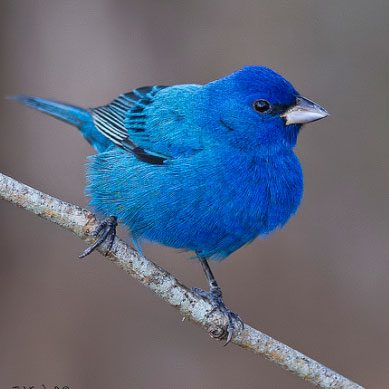Climate Change or Habitat Loss? Study Weighs Future Priorities for Conserving Forest Migrants
By Pat Leonard
July 24, 2017
Birds are among the first to let us know when the environment is out of whack. But predicting what might happen to bird populations is tricky. Studies often focus on a single issue or location: breeding grounds or wintering grounds, changes in climate, loss of habitat. But in the real world, nothing occurs in isolation. A new study just published in the journal Global Change Biology pulls the pieces together.
“This is really the first study to measure the combined impact of climate change and land-use change over a bird’s full annual cycle,” says lead author Frank La Sorte at the Cornell Lab of Ornithology. “Typically, studies tend to focus on the breeding season. If you do that, you’re missing the real story which is inherently dynamic and complex.”
The study merges projections for climate change with land-use change to model what the future might look like for 21 species of forest birds. Scientists ran dozens of scenarios to learn which combinations of factors would make this group of flycatchers, vireos, and warblers—all of which breed in eastern North America and winter in Central America—even more vulnerable to population decline.
Two key findings stand out:
- Over the next few decades, already-declining populations of these study species may become even more vulnerable on their wintering grounds because of human-caused habitat loss.
- By the end of this century, expected changes in rainfall and temperature may reduce available habitat and food on wintering grounds even further, threatening the birds’ ability to survive.
To reach these conclusions, study authors first set out to establish where the 21 species are currently found and in what density for every week of the year in every 4-square-mile block of land north of the Equator. They used observations that volunteers entered into the eBird database from 2004 through 2014. Then, they layered in modeled climate change projections (temperature and rainfall) from the 2013 Intergovernmental Panel on Climate Change and habitat data (land-use changes) from a variety of projects conducted by academic researchers, and the location of protected areas.
The authors found the 21 study species spend the majority of the year (approaching 60%) on their wintering grounds in Central America, where they occur in higher numbers and densities.
“Our findings indicate that land-use change on their wintering grounds in Central America may be the most pronounced threat for these birds over the next few decades,” says La Sorte. “That means more individuals of more species are likely to be exposed over a longer period of time to habitat loss as people continue to convert forests to cropland or grassland.”
“With this novel modeling approach, we can now put a number on how concentrated bird populations really are and hone in on areas such as northern Central America that are super-important for wintering migrants and where the threats they face are magnified,” says Cornell Lab conservation scientist Kenneth Rosenberg, a coauthor of the study. “This allows us to direct scarce conservation resources to where they are needed most.”
To address the habitat loss threat, the study’s authors recommend conservation organizations work with agencies that have authority over public lands in Central American countries—the goal being to protect more land from development and to find ways to better protect the public lands that already exist, as a sustainable forestry project in northern Guatemala has done.
“Effective conservation ultimately requires collaboration with local communities and governments,” says Amanda Rodewald, conservation director at the Cornell Lab and another of the study’s authors. “We need to develop conservation approaches for ‘working landscapes’ so that both social and ecological needs are served.”
Over the long term—by the end of this century—the 21 migrants studied are likely to encounter these altered climate conditions:
- Greater warming on the northern breeding grounds and during migration—a surface temperature increase of about 9°F (5°C) with uncertain consequences for breeding and migration success; a smaller increase of about 5.4°F (3°C) is projected for their wintering grounds.
- Less rain on the nonbreeding grounds: a projected decline of 20% or more during the summer would reduce available habitat and food for birds arriving after fall migration.
- More rain on the breeding grounds, nearing 25% more during the winter on their breeding grounds. This could enhance vegetation growth and increase insect densities for returning spring migrants—a positive trend if the birds arrive at the right time.

Timing is a crucial long-term climate-change threat, creating a potential disconnect between when migrants depart their wintering grounds—departure timing is based on amount of daylight—and the availability of food when they arrive on the breeding grounds.
This study highlights the interconnectedness and importance of far-flung locations for birds. Even if a threat does not exist in our own backyards, what happens elsewhere still has an impact on “our” birds. For example, the Wood Thrush—one of the species in this study—has actually been expanding its northern range as nature reclaims abandoned farmland. But the Wood Thrush population has still declined by more than 30% since 2009. The cause of this decline likely has to do with conditions on the bird’s wintering grounds throughout Central America.
Though the study brings together the possible effects of climate and land-use change, additional human-caused threats to birds will surely remain part of the equation, including light pollution, window collisions, and cat predation.
“Human activities are placing pressure on bird populations from many different angles at varying intensities,” says La Sorte. “Birds are responding with tools designed to function under gradual environmental change—but how effective this will be under rapid change occurring from many different sources is not well understood.”

All About Birds
is a free resource
Available for everyone,
funded by donors like you
American Kestrel by Blair Dudeck / Macaulay Library



